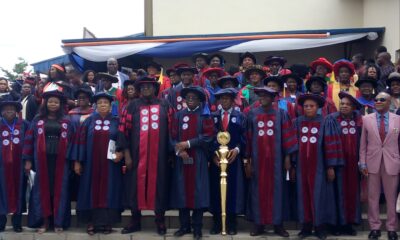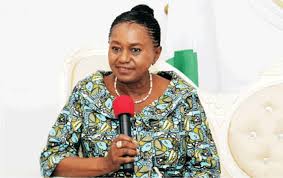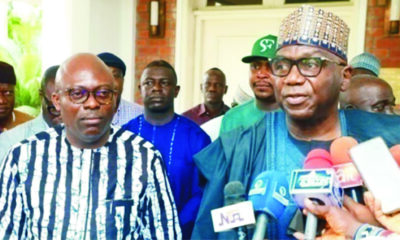Oil & Energy
Akwa Ibom Fishermen And Oil Spillage
Fishermen in Akwa Ibom in February 2011, held a prayer session to seek God’s intervention to stop oil spillage in the area.
Their prayer appeared answered as there was no case of spillage in the Qua Iboe oil fields for 10 months.
However, the December 20 Bonga oil spillage in the same year, in which 40,000 barrels of crude oil were discharged into the Atlantic Ocean, took industry watchers by surprise.
The spillage which emanated from the Bonga deep-sea oil facility operated by Shell Nigeria Production and Exploration Company (SNEPCO), ExxonMobil, Eni and Total as joint venture partners with NNPC, is located about 120 kilometres from the coastline and accounts for 200,000 barrels of crude oil per day.
The oil fields are named after a local fish species, Bonga. The fish is notable for its resilience and unique taste and suitable for most dishes along the West African coastline.
The Director-General, National Oil Spill Detection and Response Agency (NOSDRA), Dr Peter Idabor, says the spill covers approximately 950 squre-kilometres in the ocean surface.
Seven months after the spill, the agency imposed a $5 billion administrative fine on Shell.
Idabor says the fine is for impact of the spill on the sea and aquatic lives.
“Looking into the sea, the 40,000 barrels oil spill impacted about 950 squre-kilometres. beneath the sea bed. So as we speak, there is still a lot of oil at the bottom of the ocean which has not been cleaned up,” Idabo says.
“Let me note here that this administrative fine is different from compensation, because investigations are ongoing, and Shell may also pay compensation if we determine more damage.”
The NOSDRA boss notes that as a result of the spill, the livelihood of the people in the communities along 120 kilometres to Bonga has been affected.
“Due to contamination of the open water, there are job losses as the people are mainly fishermen, and this has also led to high incidence of migration of the people from these communities in search of fresh water.”
The people of the area were not so lucky in 2012, as three spill incidents have occurred within the year, on August 13, August 24 and November 9 at the Qua Iboe oil fields.
Chairman, Esit Eket Local Government Council, Chief Ibanga Etang, says the November 9 spill impacted negatively on fishing communities in southern Akwa Ibom.
“The spill contaminated the water, causing fish drought and distorting the marine food chain.
“Whenever a spill occurs, fishermen are thrown out of business because when the waters become toxic, fishes migrate from the reach of fishermen.
“The recurring spills put to question the claims by Mobil management that it has replaced aged pipeline network,’’ Etang notes..
Mrs Udual Eyo-Sunday, a fish seller, says that they were adversely affected by the oil spill.
“Whenever there is oil spill, the fishermen do not bring fish back from the waters and when we cannot buy fresh fish, we have nothing to dry and sell.
“We find it difficult to feed our children and the situation will continue for a long time.
“That is why we need relief materials and compensation for the damage to our source of livelihood,’’ Eyo-Sunday says.
A community leader in Ibeno Local Government, Chief John Etim, describes the latest spill as the worst in recent times.
He says that frequent spills have impoverished the fishing population on the coastline.
“Oil spills have been a major obstacle to our fishermen and it is worsened by the insensitivity of Mobil in the past. But we have seen signs that they are turning a new leaf.
“The way Mobil Producing Nigeria (MPN) has communicated with the communities gives us hope amidst disappointment. We, however, urge them to be reasonable and compensate every one that was impacted,’’ Etim says.
The fishermen, who operate under the aegis of Artisan Fishermen Association of Nigeria (ARFAN), say a safe operational environment at the oil fields will support fishing activities and ensure food security in the country.
Chairman of ARFAN in the state, Rev. Samuel Ayadi, says that the fishermen have suffered untold hardship since 2010 due to frequent oil spills.
“Many fishermen were forced out of business for the greater part of the year due to pollution of the Atlantic by oil and gas companies operating within our territorial waters, he says.
Ayadi explains that although 2011 was spill-free from January till December, fishermen in the state were yet to receive any compensation for the previous incidents.
The association’s chairman also notes that due to the rigorous oil spill compensation process, fishermen are always at the losing side whenever a spill occurred.
“Our existing laws on oil spill compensation favour the international oil companies to the detriment of fishermen who lack the resources to pursue their claims.
“We have oil spill compensation claims that have been pending for more than 10 years and even the cases we won in court, the companies refuse to comply with such judgment.’’
Ayadi stresses the need for a harmonious relationship between the host communities and oil companies.
“The Atlantic Ocean where the oil companies operate is our ‘farm’. We are there day and night and whenever there is an oil spill or any interference with oil installations, we are the first to know and report to the security agencies.
“The companies should see us as their neighbours,” Ayadi adds.
To ensure a cordial relationship between Mobil and host communities, Akwa Ibom Government in October, 2011 set up a committee to produce a Memorandum of Understanding (MoU).
The stakeholders at the meeting regretted the deteriorating relationship and promised to work together for the common good of all.
They also pledged to hold regular dialogue and consultations to build a cordial relationship that would ensure peaceful operations at the Qua Iboe oil fields.
Stakeholders have therefore, suggested that oil companies should hold regular consultations with oil producing communities, to reduce frictions.
They also stress the need for the companies to maintain their facilities to check avoidable oil spillage.
Nwakamma writes for News Agency of Nigeria (NAN)
Nathan Nwakamma
Oil & Energy
FG Explains Sulphur Content Review In Diesel Production
The Federal Government has offered explanation with regard to recent changes to fuel sulphur content standards for diesel.
The Government said the change was part of a regional harmonisation effort, not a relaxation of regulations for local refineries.
The Chief Executive, Nigerian Midstream and Downstream Petroleum Regulatory Authority (NMDPRA), Farouk Ahmed, told newsmen that the move was only adhering to a 2020 decision by the Economic Community of West African States (ECOWAS) which mandated a gradual shift to cleaner fuels across the region.
Ahmed said the new limits comply with the decision by ECOWAS that mandated stricter fuel specifications, with enforcement starting in January 2021 for non-ECOWAS imports and January 2025 for ECOWAS refineries.
“We are merely implementing the ECOWAS decision adopted in 2020. So, a local refinery with a 650 ppm sulphur in its product is permissible and safe under the ECOWAS rule until January next year where a uniform standard would apply to both the locally refined and imported products outside West Africa”, Ahmed said.
He said importers were notified of the progressive reduction in allowable sulphur content, reaching 200 ppm this month from 300 ppm in February, well before the giant Dangote refinery began supplying diesel.
Recall that an S&P Global report, last week, noted a significant shift in the West African fuel market after Nigeria altered its maximum diesel sulphur content from 200 parts per million (ppm) to around 650 ppm, sparking concerns it might be lowering its standards to accommodate domestically produced diesel which exceeds the 200 ppm cap.
High sulphur content in fuels can damage engines and contribute to air pollution. Nevertheless, the ECOWAS rule currently allows locally produced fuel to have a higher sulphur content until January 2025.
At that point, a uniform standard of below 5 ppm will apply to both domestic refining and imports from outside West Africa.
Importers were previously permitted to bring in diesel with a sulphur content between 1,500 ppm and 3,000 ppm.
It would be noted that the shift to cleaner fuels aligns with global environmental efforts and ensures a level playing field for regional refiners.
Oil & Energy
PHED Implements April 2024 Supplementary Order To MYTO
The Port Harcourt Electricity Distribution (PHED) plc says it has commenced implementation of the April 2024 Supplementary Order to the MYTO in its franchise area while assuring customers of improved service delivery.
The Supplementary order, which took effect on April 3, 2024, emphasizes provisions of the MYTO applicable to customers on the Band A segment taking into consideration other favorable obligations by the service provider to Band A customers.
The Head, Corporate Communications of the company, Olubukola Ilvebare, revealed that under the new tariff regime, customers on Band A Feeders who typically receive a minimum supply of power for 20hours per day, would now be obliged to pay N225/kwh.
“According to the Order, this new tariff is modeled to cushion the effects of recent shifts in key economic indices such as inflation rates, foreign exchange rates, gas prices, as well as enable improved delivery of other responsibilities across the value chain which impact operational efficiencies and ability to reliably supply power to esteemed customers.
“PHED assures Band A customers of full compliance with the objectives of the new tariff order”, he stated.
Ilvebare also said the management team was committed to delivering of optimal and quality services in this cost reflective dispensation.
The PHED further informed its esteemed customers on the other service Bands of B, C D & E, that their tariff remains unchanged, adding that the recently implemented supplementary order was only APPLICABLE to customers on Band A Feeders.
Oil & Energy
Renewable Energy Boom With Waste Problem

As the global renewable energy capacity increases, so does the amount of waste from end-of-life equipment from solar, wind and other renewable energy activities. If we don’t address this problem soon, it could become a whole new threat to the environment and human health.
While a transition away from fossil fuels to alternative green energy sources is helping the world to reduce its greenhouse gas emissions and combat climate change, it is important to consider the implications that new energy activities may have on the environment.
Solar panels and wind turbines have a limited lifespan and need to be disposed of appropriately once they reach this point. While some components can be recycled and reused, much of the old equipment ends up in landfills due to the lack of infrastructure in place to manage the materials suitably.
Renewable energy equipment, such as solar panels, contains components that can be harmful to humans, such as lead and cadmium, as well as other materials, like glass, aluminum, and silicon, which can be harmful to the environment if disposed of improperly.
One way that out-of-use equipment can be managed is through the creation of standards, such as the Waste Electrical and Electronic Equipment (WEEE) directive from the European Union, which provides guidelines for the gathering, handling, recycling, and recovery of solar panels.
The U.S. Resource Conservation and Recovery Act (RCRA) also addresses the correct disposal of solar panels.
However, many countries have yet to introduce clear standards for renewable energy equipment disposal, which has led to dangerous methods of disposal.
Several countries around the globe are rapidly increasing their solar and wind energy capacity, which relies on the production and installation of millions of solar panels and turbines. Tens of millions of solar panels are being installed each year in the U.S. alone, and globally the figure is over a hundred million.
Despite the accelerated pace of the rollout, there are few recycling facilities prepared to manage old equipment.
Some countries are managing equipment disposal better than others. For example, France claims that 90 percent recycling efficiency is achieved in some of its flagship disposal facilities.
However, others do not have mechanisms in place to even consider recycling old equipment. While it is important to put proper waste disposal mechanisms in place for the safety of people and the environment, it can also be a lucrative business.
According to a study by the International Renewable Energy Agency (IRENA) and the U.S. Department of Energy’s National Renewable Energy Laboratory (NREL), the cumulative value of materials that can be recycled from solar photovoltaic (PV) waste is estimated at $4 billion by 2040 and $8.8. billion by 2050.
Supplies of many of the materials used to produce green energy equipment are finite, meaning it is important to recycle materials to reproduce equipment to continue to produce renewable energy. Jinlei Feng, a programme officer at IRENA, explained, “By 2050, there will be more than 210 million tonnes of cumulative solar PV waste globally and more than three-quarters of that waste will be generated after 2040 and 40% in the last five years between 2045-2050”.
Feng added, “Annual solar PV waste generation will touch 10 million tonnes by 2040 and increase to 20 million tonnes by 2050”.
India is currently trying to navigate solar waste problem. Pavagada in the south of India is home to the world’s third-largest solar power plant, which holds 25 million panels across a 50 km2 park, with a capacity of 2,050MW. There are 11 other giant solar parks across the country, with plans to develop a further 39 across 12 states by 2026.
However, with great solar ambitions comes significant waste. India is aiming for a solar output capacity of 280GW by 2030, of which 70.1GW is already installed.
One study predicts that this will produce an accumulation of over 600,000 tonnes of solar waste by the end of the decade, which could increase 32-fold to over 19 million tonnes by 2050.
Although there are protocols in place to manage the disposal of old equipment, which state that solar waste from the plants must be transferred to e-waste contractors, authorized by the Central Pollution Control Board (CPCB), within a specified timeframe – typically 90 or 180 days – few abide by these rules.
Most solar farms are in remote areas and must pay to transport old equipment to authorised contractors. Solar glass has no real value, meaning there is little incentive for waste contractors to collect and manage the equipment.
This has led to the development of a network of informal operators – who dismantle, aggregate, transport and recycle panels.
Instead of ensuring proper disposal methods are followed, many operators sell their waste equipment to informal buyers, meaning the materials cannot be recycled and repurposed, and many of the materials end up harming both people and the environment.
To ensure that renewable energy equipment is disposed of appropriately, and recycled where possible, governments must establish clear standards and regulations for energy waste disposal.
Further, they must ensure the mechanisms are in place and funding is available to guarantee proper disposal takes place. Without the necessary standards, green energy equipment could contribute to environmental and health problems in the coming decades.
Bradstock writes for Oilprice.com.
By: Felicity Bradstock
-

 Rivers4 days ago
Rivers4 days agoPolice Arrest Vigilante Commander, Others Over Robbery In Rivers
-

 Education4 days ago
Education4 days agoFormer VC Advocates Drug Test For University Lecturers
-
News5 hours ago
Reps Order NERC To Suspend Implementation Of New Electricity Tariff
-

 News4 days ago
News4 days agoSpeak Truth To Power, Prof Omotola Tells Journalists
-

 Politics4 days ago
Politics4 days agoBayelsa Repositioning Local Councils For Service Delivery – D’Gov
-
Niger Delta4 hours ago
Calabar Port Dormant In 25 years -Manager
-

 Nation4 days ago
Nation4 days agoWIW: Banigo Advocates Legislative Impetus
-

 News4 days ago
News4 days agoLet’s Fight To Save Rivers’ Soul Together

